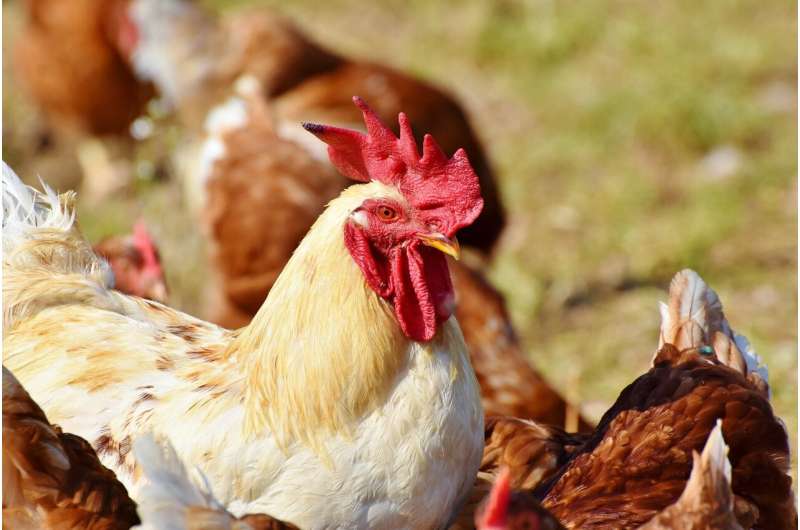This article has been reviewed according to Science X's editorial process and policies. Editors have highlighted the following attributes while ensuring the content's credibility:
fact-checked
trusted source
proofread
The good, bad and essential: Microbes that affect food and health

EU researchers are examining how bacteria, fungi and other microorganisms could boost the health of both plants and animals.
When Professor Tom Gilbert and his colleagues were researching how different diets affect chickens in 2019, something strange happened: one batch of chicks grew much more slowly than in two previous trials.
And this was despite the chickens living in the same highly controlled environment with identical diets and food supplements.
Small changes, big effects
So what changed? The only possible difference was that the chicks had been exposed to unidentified microbes on their journey from the hatchery in the Spanish region of Catalonia, according to Gilbert, a geneticist at the University of Copenhagen in Denmark.
The microbes that the chicks ingested would have been part of the vast array of microorganisms—including bacteria, fungi and viruses—that exist in the environment, people and animals and that are collectively called the microbiome.
"This gave us an extremely interesting insight into how very small differences in the microbiome in the early stages of life can have big knock-on effects on an animal's development and big consequences for farming," Gilbert said.
The research carried out by his team was part of a project that received EU funding to investigate the impact of feed and supplements on the microbiome and, ultimately, the health of chickens and salmon.
Called HoloFood, the project ended in April 2023 after almost four and a half years.
How animals' genetics and their microbiome interact is a rapidly growing area of research known as hologenomics. The word comes from the term "holobiont," which describes a host species and the collection of microbes and other species living in or around it in a mini ecosystem.
Microbes present in the environment colonize the gut of an animal as soon as it is born, creating a community teeming with trillions of both beneficial and potentially harmful bacteria, viruses and fungi.
The microbiome of a person or an animal has a big influence on health, affecting growth and immune responses and regulating nutrient intake. It is even thought to affect human behavior, including social interaction. Meanwhile, microbes in plants and soil affect crop growth and resilience.
Greener guts
Finding ways to optimize the microbiome could be one route to ensuring healthier food for a growing global population.
It could also ease the environmental impact of farming by reducing the need for fertilizers, antibiotics and other chemicals.
Research in this area is part of Europe's Food 2030 initiative, which aims to spur a transition towards greener, healthier and more accessible diets.
The science of exactly how microbes could be harnessed to enhance the health, productivity and quality of agricultural production is still in the early stages.
Helped by advances in DNA sequencing that shed greater light on microbial communities, HoloFood laid the ground for a better understanding of the impact of food substances and supplements on the microbiome and—ultimately—on animal health.
This type of research could eventually aid the development of sustainable food production.
In trials, fish fed on seaweed and mussels—more sustainable additives and protein alternatives to traditional feed—turned out to be just as healthy and grew just as well.
"That's actually a big win because it means you can replace foodstuffs like imported soy," Gilbert said.
Homegrown answers
Another EU-funded project, SIMBA, produced some similar findings during its five-year run until the end of October 2023.
The researchers found that part of traditional soy-based fish feed can be replaced with a mix of more sustainable, locally sourced rapeseed meal and seaweed with no negative effect on the gut microbiome.
This offers the promise of developing aquaculture sources in the EU rather than importing large amounts of soy from the Americas, according to Dr. Anne Pihlanto, a food and bioproducts researcher at the Natural Resources Institute Finland in Helsinki.
"The fish grew well with the alternative feed, suggesting that some of the soy can be replaced with materials that are available here in Europe," said Pihlanto, who led SIMBA.
Understanding microbial communities could help make other forms of food production—such as the cultivation of crops—more sustainable too.
The researchers investigated how microbes affect growth and resistance to certain diseases or environmental conditions like drought. The repercussions are potentially enormous.
"If we can find the right microbes, they could help at least partly replace fertilizers, improving resilience in the food system," said Pihlanto.
Plant resilience
The researchers found that inoculating Arabidopsis plants—often used as model organisms—with a mix of four particular microbe species resulted in increased drought tolerance. This hints at a potential to improve resistance in other crops too.
They identified further microbial mixes that aided the growth of wheat—perhaps through enhancing the uptake of nitrogen—and that improved the yield of potatoes grown in salt marshes.
The implications for harnessing seawater for irrigation in areas of the world unsuitable for cultivation are potentially significant.
Projects like HoloFood and SIMBA have opened up the field for future research into how microbes can make food production healthier and better for the planet.
The knowledge generated by both projects is available on the HoloFood Data Portal and the SIMBA open-access database, adding to information about the microbiome also emerging from other EU-funded research initiatives including 3D-omics and FindingPheno.
"I hope knowledge will keep improving so we know what kinds of microbes we should use in different places," said Pihlanto. "We still need a lot of further knowledge."
Provided by Horizon: The EU Research & Innovation Magazine





















